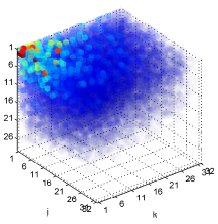Block component analysis
IWT - PhD project (01-01-2011 tot 31-12-2014)
Researchers
- L. Sorber
- L. De Lathauwer (ESAT) (promotor)
- M. Van Barel (promotor)
Description

The column (row) rank of a tensor is the dimension of the vector space spanned by its columns (rows). Contrary to matrices, for tensors column and row rank are not necessarily equal. The multilinear rank of an Nth-order tensor is defined as the N-tuplet consisting of column rank, row rank, ... A rank-1 tensor is defined as the outer product (tensor product) of a number of nonzero vectors. The rank of a tensor is then equal to the minimal number of rank-1 terms into which it can be decomposed. For tensors, multilinear rank and rank are generally different. This is again a difference with matrices, where column/row rank and minimal number of rank-1 terms in a decomposition are equal.
The two most important tensor decompositions are the Tucker decomposition and the canonical polyadic decomposition (CPD). The Tucker decomposition is multilinear rank-revealing and the CPD is rank-revealing. Given a tensor that has multilinear rank (R1, R2, ..., RN), the Tucker decomposition computes the R1-dimensional column space, R2-dimensional row space, and so on, and projects on them, yielding a so-called core tensor of dimension (R1 x R2 x ... x RN).
CPD on the other hand, is the decomposition in rank-1 terms. L. De Lathauwer introduced Block Term Decompositions (BTDs) as the concept that unifies the Tucker decomposition and the CPD. BTDs decompose a given tensor as a sum of terms of low multilinear rank. The Tucker decomposition is the special case in which there is only one term. The CPD is the special case in which all the terms have a scalar core, i.e., the multilinear rank of all terms is (1,1, ..., 1), which means that they are rank-1. BTDs do not have a matrix counterpart. It goes without saying that BTDs are a very fundamental new concept. In this project we will study the uniqueness of BTDs, derive algorithms for their computation, work out a BTD-based new approach to the factor analysis problem, make the link with Nonnegative Matrix Factorization and develop particular extensions.
See also PhD project Laurent Sorber.

|

|
|


_BTD.png)
_BTD.png)
_BTD.png)